Alternate Impact Point Re-Surfaces
by Mike Hankey, under Mason Dixon Meteor
I got an email today from a meteorite enthusiast named George. George disputed the authenticity of my meteor picture. He suggested the following at the conclusion of a lengthy unresolved debate.
My suggestion though is to not use your photo for any source of finding a strewnfield. I think you would have better luck in the long run.
When I got home I emailed Dirk Ross (Tokyo) from Lunar Meteorite Hunters Blog and asked him to give me a call. Dirk has been helping me out with the meteorite hunt and he really knows his stuff. I told Dirk about the email exchange I had with George and he told me that when my picture first surfaced it was immediately scrutinized. There were dozens of emails on the meteorite list with the subject “Astro Mike”. All of the hardcore meteorite dudes were debating whether or not my picture was really a meteor and not something else (like a plane). There were basically two camps: the believers and the doubters. Because the opinion was initially disputed the trajectory experts were not considering the data obtained from my picture at all. Dirk Ross was one of these meteor trajectory wizards and he plotted an impact zone days after the fall. Dirk with the help of Elton Jones and others plotted the trajectory estimate and impact zone using only the York Water meteor video and eye witness reports.
Unfortunately no one listened to Dirk and instead they went with a ‘due east’ trajectory past York. This resulted in 100s of lost video recordings of the meteor. The city of Lancaster alone apparently recently installed a security system that has cameras on every street corner in the city (thanks for letting me know this M Gaines). Security video recordings are usually only saved for 7 days and then overwritten. The ground work to look for security cameras was focused in the York area. No security videos were ever recovered from Lancaster. No matter, two new videos did surface: Safe Harbor and the Pittsburgh fireball video. The Pittsburgh video (also found by Dirk), shows 3 stars and the planet Jupiter. This stellar information in combination with my stellar picture and the York Water Fireball Video and Safe Harbor videos gave Rob Matson and Marc Fries abnormally good data for a fireball trajectory.
Here is the kicker: Dirk Ross’s initial impact point is roughly 10 miles from the impact point Marc Fries and Rob Matson calculated using ALL of the video evidence. Dirk, that is pretty darn good.
George thanks for doubting my picture. Looking at Dirk’s data makes me feel extra special confident about the location we are working in right now. I wouldn’t have run into this new data if we hadn’t had our email debate.
Here are the Google Earth maps that show both Dirk Ross’s projection (using only York and eye witnesses) and Rob Matson/Marc Fries projection (using all available data).
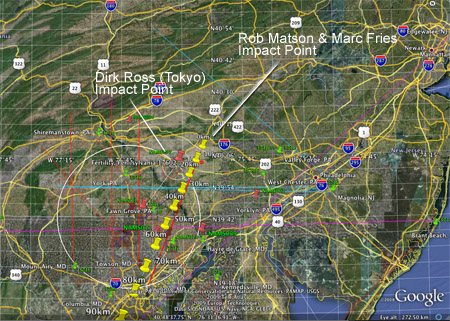

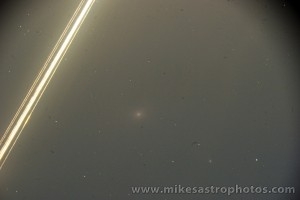
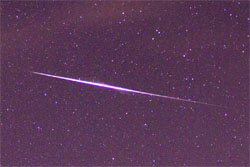
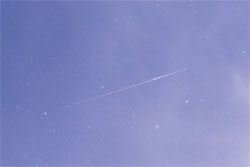
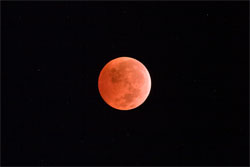


August 13th, 2009 on 1:13 am
Unfortunately, in statistics and probabilities, there is the certainty that you will eventually be wrong when siding with the majority of the data points. When initially plotting the AMS and blog reports to Google Earth, we had raw reports as we had not been able to do any follow up interviews. In absence of clues suggesting a particular witness was more accurate, I chose to go with the majority of reports which statistically were, by definition, more probable than improbable. In this case the accuracy lay with the minority reports. That is to say that the majority of folks who were kind enough to submit a fireball report were wrong about their orientation. This is an all too common situation that we ourselves have made assumptions about which way our windows ands doors actually face. Only with the slow accumulation of photographic records were we able to resolve gross trajectory. Even then, there were debates over hard data within those photos.
I allowed my confidence in the majority of reports to outweigh the minority reports that seemed to counter what most others thought they saw. The original estimate of a flat East to West trajectory fit perfectly by the book–but the results were very wrong. This reiterates the need for a cadre of trained field interviewers with the time and means to respond to a fireball event.
Another lesson learned is to solicit security cam video in a 120 mile radius of the best cluster of witnesses. Soliciting information through the state emergency action center’s message system–IF you can get approval–is probably the most efficient means to canvas a lot of police departments in a timely manner. This is a tip we will add to our handbook. Again this illustrates a gap in the way we do business in the US. The Canadians have a well established alert system when a fireball occurs which includes governmental support. NASA proper won’t even return mail or phone calls owing to their “no my yob” policy. There is no specific authority/agency to investigate fireballs and a subsequent reluctance by if not downright dismissal for requests for cooperation from government agencies.
August 13th, 2009 on 8:03 am
It’s too bad the US doesn’t have a system for supporting fireball follow-ups. Had this meteor been space junk loaded with hazardous materials, such a system would help locate the debris.
August 13th, 2009 on 1:37 pm
Elton,
My post was in no way meant to be critical of the initial work you did as this was a team effort all around and the ground work you did lead us to where we are now. Your data helped Dirk pinpoint the impact zone. It seems the error in the initial trajectory really stemmed from the fact that the York video camera had a fish eye lens and Dirk was the only person that noticed this or at least made corrections for this. His correction for the distortion in the york video combined with the M Gaines witness report lead him to his projected impact point (which is 10 miles away from Rob Matson’s and Marc Fries projected point).
I guess my only criticism with the initial ground operations was the lack of recovery for video tapes. I was not working the ground until 5 days after the fall, I was new to all of this and I really thought the ‘experts’ had it under control. When I started looking for video tapes 3 weeks later, I thought to myself…. damn there are video cameras all over the place, how did we miss these. Your comments about the Canadian fireball network are very interesting, but I understand and accept that this is not a government responsibility (although it probably should be). Its kind of scary that the entry point of this projectile was less than 50 miles away from Washington DC (100km up). If this thing was headed south instead of north it could have landed on the White House lawn. Knowing that there are Russian missile subs patrolling international waters just off the east coast really makes me wonder about what the government is doing and what their not. I sincerely hope the government has this fireball captured on a satellite video that was designed to catching incoming ICBMs and they simply will not share the information due to National Security. The day I took the picture, I sent it to NORAD, NASA & NOAA. Its been 30+ days since then and they never even sent me an acknowledgment that they received the information. So relying on the US Government to help find fireballs is a big no-go.
You mention having a ‘play book’ that we as a community should follow after a fall. I couldn’t agree more. I think there was way to much reliance put on the media to spread the word regarding video recovery. What I’ve learned being in the field since the start is, most people in the rural areas were not aware of the fall. A 2 minute news clip on one night, or even a front page article in a newspaper is not enough to get someone to look at their video tapes. It takes people on the ground knocking on doors and saying — look at your video now!!! What I do think we should do is actually develop and publish the ‘Fireball Fall Day After Playbook’. There should be several chapters in this book about how to respond the day after a fireball report. We should focus on soliciting and training members of the AMS to conduct field work, witness interviews and security cam recovery efforts. The people in this group are already looking for meteors in the sky and I’m sure most of them would be stoked to help out on the ground.
With anything hind site is 20/20. Thank you for your outstanding efforts with trying to locate and recover The Mason Dixon Meteor.
Mike
August 13th, 2009 on 3:10 pm
Until recently fireball data which was captured on our NTBT Compliance satellites was sanitized and released to the public. A Dr Peter Brown a Canadian at NASA(?) posted the data on his website but he has migrated back to Canada and seems to have a tiff against US based researchers and will not cooperate any longer.
As to contacting NORAD or any other USAF agency they are just as much in the dark as you are. A bit of background: until recently it was classified that it was classified– the Air Force would not even admit that they were no longer providing satellite data. It slipped out somehow so the USAF released a notice that it had classified fireball data. I too had spent 8 weeks trying to locate data on the Ky and Ash Creek fireballs. Recently , due to outcry from researchers the USAF announced they were going to resume sharing fireball data and were working out the details of release. Traditionally these reports were released by the public affairs office for the USAF ATS agency at Patrick AFB in Florida.
My previous comment was just for illustration as to why things aren’t as perfect as we might think when it comes to fireball events. It is both art and science. I was just adding the details about the first few days so folks following this blog understood the whys and hows and of what went wrong and went right. No offense intended nor taken.
So Mike, how does it feel to know you’ve jumped from backyard astronomer to experienced fireball field investigator in a 4 short weeks? Welcome to the club!
August 13th, 2009 on 5:25 pm
Thanks Elton!
It feels great! I’m loving it!
August 14th, 2009 on 10:11 am
Elton,
You deserve a great share of credit for collecting all of the eyewitness reports and plotting them on Google Earth.
The photos in the newspapers of the York camera and the camera shot itself indicated to me that the photo was greatly distorted at the edges due to the lens type.
It was really exciting to see Allison`s video camera shot of the fireball and to have her answer my urgent email and then talk with her from Tokyo on the other side of the Earth during the middle of my night. After seeing the video and contacting Allison I contacted the Meteorite-List and Meteorobs and then emailed Mike Hankey and Elton. What an exciting day!
Now it is time for John, Elton or Mike to pull at least one of these “rocks from the sky” into view on the ground and collect them. Best Regards, Dirk Ross…Tokyo